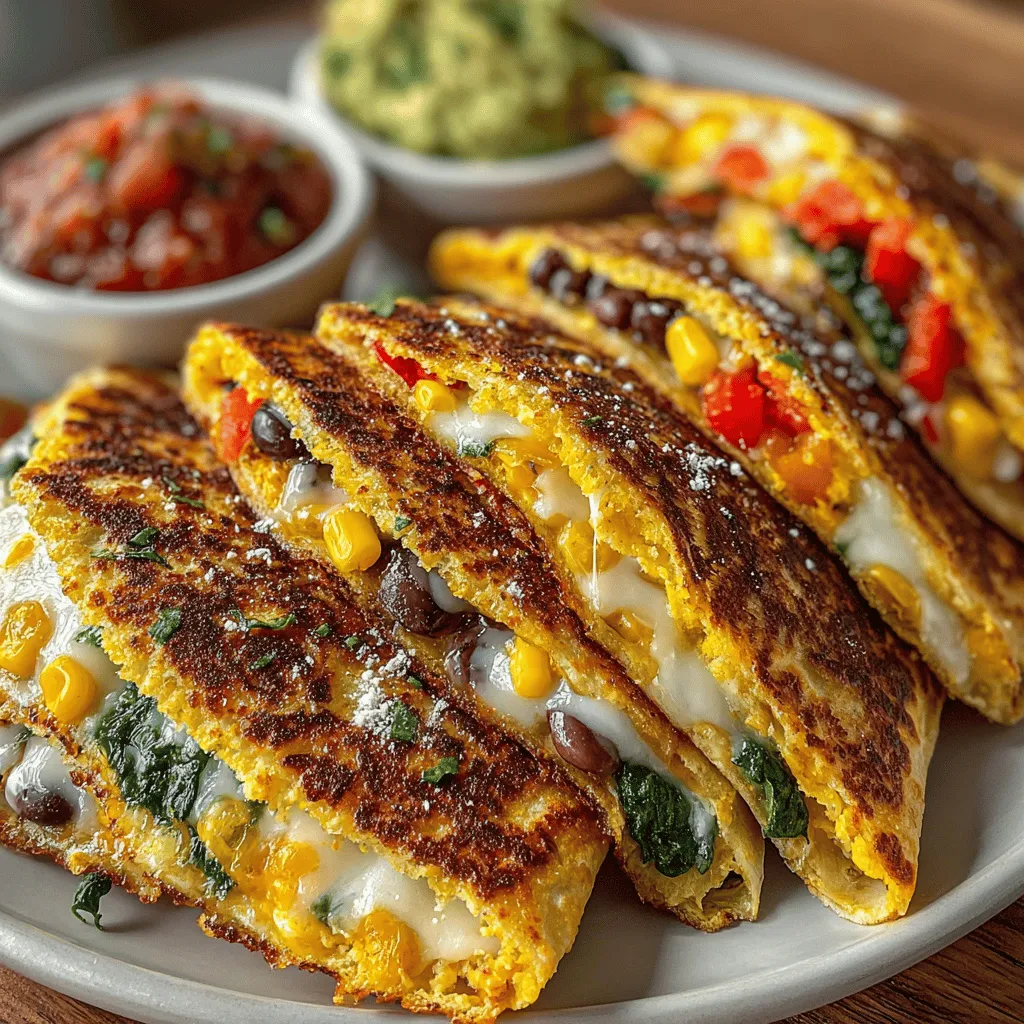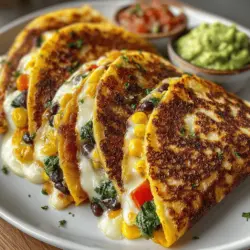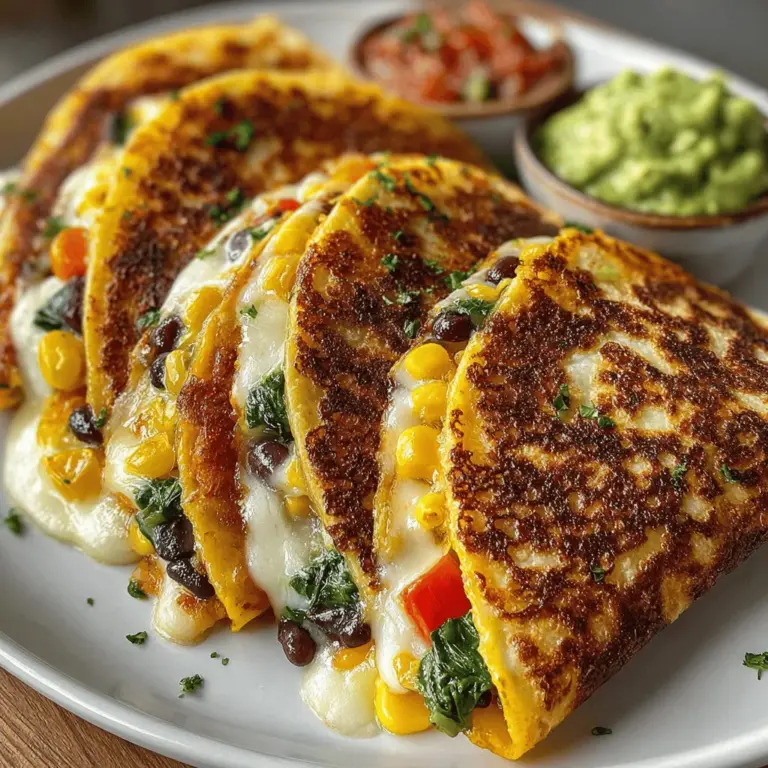Rainbow Veggie Quesadillas for Kids: A Fun and Nutritious Recipe
In today’s fast-paced world, encouraging children to adopt healthy eating habits can be a challenging endeavor for many parents. With the abundance of processed foods and sugary snacks available, it’s essential to find creative ways to introduce nutritious options that not only fuel their growing bodies but also entice their taste buds. One delightful solution is the Rainbow Veggie Quesadilla, a vibrant, colorful dish that combines wholesome ingredients with an appealing presentation.
These quesadillas are not just a visual feast; they are a powerhouse of nutrition, packed with essential vitamins, minerals, and fiber that children need for their development. The combination of colorful vegetables and gooey cheese makes this meal an exciting option that kids will love. In this article, we’ll explore the appeal of Rainbow Veggie Quesadillas, break down the ingredients, and guide you through the initial steps of preparing this family-friendly dish.
Understanding the Appeal of Rainbow Veggie Quesadillas
Color plays a crucial role in attracting children to food. Studies have shown that kids are often more inclined to try new foods when they are vibrant and visually appealing. The Rainbow Veggie Quesadilla capitalizes on this concept, featuring an array of colorful vegetables that catch the eye and spark curiosity. Each color represents different nutrients, making it a fun way to introduce variety into a child’s diet.
Incorporating a wide range of vegetables into meals can significantly benefit a child’s health. Each vegetable comes with its unique set of vitamins and minerals, which contribute to overall growth and well-being. For instance, bell peppers are rich in vitamin C, while spinach provides iron and other essential nutrients. By presenting these veggies in a familiar format like quesadillas, parents can encourage their children to enjoy healthier options without the usual fuss.
Moreover, whole wheat tortillas and cheese add to the nutritional profile of this dish. Whole wheat tortillas offer more fiber and nutrients compared to their white flour counterparts, helping to keep kids feeling fuller for longer. Additionally, cheese is an excellent source of calcium, which is vital for developing strong bones and teeth. Together, these ingredients create a balanced meal that is both nourishing and satisfying.
Ingredients Breakdown
To create the perfect Rainbow Veggie Quesadilla, you’ll need to gather a selection of fresh ingredients that not only taste great but also provide essential nutrients. Let’s break down the main components of this recipe:
1. Whole Wheat Tortillas: Using whole wheat tortillas instead of refined flour tortillas is a simple switch that can significantly enhance the nutritional value of your quesadilla. Whole wheat tortillas contain more fiber, vitamins, and minerals, making them a healthier option that can aid digestion and promote a healthy lifestyle. If whole wheat tortillas are not available, consider alternatives like corn tortillas or other whole grain varieties.
2. Mozzarella Cheese: Cheese is a staple in quesadillas, and mozzarella is a popular choice due to its mild flavor and melt-in-your-mouth texture. Besides being delicious, mozzarella is rich in calcium and protein, both of which are essential for growing children. If you’re looking for lower-fat options, part-skim mozzarella is a great substitute that still provides the necessary nutrients.
3. Bell Peppers: These colorful veggies are not only visually appealing but also packed with vitamins A and C, as well as antioxidants that support overall health. Bell peppers come in various colors—red, yellow, green, and orange—each offering a slightly different flavor profile and nutrient composition. Including a mix of these peppers in your quesadilla will create a delightful burst of color and taste.
4. Spinach: Often referred to as a nutritional powerhouse, spinach is loaded with vitamins, minerals, and antioxidants. It’s a fantastic source of iron, which is important for energy production and overall vitality. To introduce spinach to kids, consider chopping it finely or sautéing it lightly before adding it to the quesadilla, making it less noticeable while still reaping its health benefits.
5. Corn Kernels: Sweet and crunchy, corn adds a delightful texture to the quesadilla. It is a good source of fiber, which aids digestion, and provides energy to keep kids active throughout the day. Fresh, frozen, or canned corn can be used in this recipe; just be sure to rinse canned corn to reduce sodium content.
6. Black Beans: These protein-packed legumes are an excellent addition to any quesadilla. Black beans are loaded with fiber, which helps maintain a healthy digestive system, and they provide a substantial amount of plant-based protein, making them a great option for vegetarian meals. Ensure that you rinse and drain canned black beans before using them to reduce sodium levels.
7. Optional Taco Seasoning: While the primary ingredients create a flavorful base, adding a sprinkle of taco seasoning can enhance the taste without introducing excessive sugars or preservatives. You can easily make your own seasoning blend using spices like cumin, chili powder, and garlic powder for a healthier alternative.
Step-by-Step Guide to Making Rainbow Veggie Quesadillas
Before diving into the cooking process, it’s important to prepare your ingredients properly. Here are the initial steps involved in making Rainbow Veggie Quesadillas:
1. Preparing the Veggies: Start by washing all your vegetables thoroughly. Use cold water to rinse off any dirt or pesticides that may be on the surface. This step is crucial for food safety and ensures that the veggies are clean and ready for cooking.
2. Chopping the Vegetables: After washing, proceed to chop the bell peppers and spinach into bite-sized pieces. For bell peppers, remove the seeds and stems to make them easier to eat. Finely chopping the spinach will help it blend seamlessly into the quesadilla, making it more appealing to picky eaters.
3. Selecting Fresh Produce: When shopping for vegetables, look for firm bell peppers with vibrant colors and fresh-looking spinach with no wilting or browning. If you’re using canned or frozen vegetables, check the labels for added sugars or preservatives, opting for options that are as close to their natural state as possible.
Once your ingredients are prepared, you’ll be ready to assemble and cook your Rainbow Veggie Quesadillas. Stay tuned for the next part of this article, where we’ll cover the cooking process and tips for serving these delicious and nutritious quesadillas to your family.

Mixing the Filling
Creating a delicious filling for your Rainbow Veggie Quesadillas is both simple and rewarding. Start by gathering a mix of colorful vegetables for a vibrant and nutritious combination. Here’s how to combine the ingredients for optimal flavor and nutrition:
1. Choose Your Vegetables: For a well-rounded filling, consider using bell peppers (red, yellow, and green), spinach, corn, and mushrooms. These vegetables not only add color but also pack essential vitamins and minerals. Aim for about 1 to 2 cups of chopped vegetables total.
2. Add Flavor: To enhance the taste, include finely chopped onions and garlic. Sautéing these aromatics in olive oil before adding the other veggies can elevate the flavor profile significantly. A pinch of salt and pepper will also go a long way.
3. Incorporating Cheese: For the cheesy goodness that kids love, mix in shredded cheese like Monterey Jack, mozzarella, or cheddar. Using a combination of cheeses can add depth to the filling. Aim for about 1 to 1.5 cups of shredded cheese per batch of filling.
4. Optional Add-ins: Consider adding cooked beans for extra protein or spices like cumin or paprika for a little kick. These additions can make the quesadillas heartier and more satisfying.
By mixing these ingredients thoroughly, you ensure that every bite is bursting with flavor and nutrition.
Variations: Alternative Veggies to Consider
While the suggested vegetables are a great start, feel free to get creative! Here are some alternative veggies to consider:
– Zucchini: Adds moisture and mild flavor.
– Carrots: Grated carrots can introduce a touch of sweetness.
– Broccoli: Finely chopped, it can add crunch and nutrition.
– Sweet Potatoes: Cooked and mashed sweet potatoes can create a creamy texture.
Experimenting with different vegetables not only keeps the recipe fresh but also encourages kids to try new flavors.
Assembling the Quesadillas
Once your filling is mixed and ready, it’s time to assemble the quesadillas. Proper assembly ensures an even distribution of filling and helps prevent any spillage during cooking.
Tips for Even Distribution of Filling and Cheese
1. Layering: When placing the filling on the tortilla, start with a light layer of cheese, followed by a generous scoop of the mixed veggie filling, and top with another layer of cheese. This helps to bind the filling together and prevents it from spilling out.
2. Portion Control: Use about 1 cup of filling per tortilla. This portion is enough to create a hearty quesadilla without overstuffing. Overfilling can lead to messy cooking and tears in the tortilla.
Techniques for Folding Tortillas to Avoid Spillage
To fold the tortillas, follow these simple steps:
– Fold Gently: Start by lifting one side of the tortilla over the filling, then gently fold it in half. Avoid pressing down too hard, as this can cause the filling to escape.
– Seal the Edges: Use your fingers to pinch the edges together, securing the filling inside. For extra insurance, you can brush a little water around the edges to help seal them.
Cooking the Quesadilla
Cooking the quesadillas to perfection is crucial for achieving that golden-brown exterior and melty cheese interior.
Optimal Skillet Temperature and Cooking Tips
1. Preheat the Skillet: Set your skillet over medium heat and allow it to warm up for a few minutes before adding the quesadilla. A well-heated skillet will help achieve that crispy texture without burning.
2. Cooking Time: Cook each quesadilla for about 3-4 minutes on one side until golden brown, then carefully flip and cook for another 2-3 minutes on the other side.
3. Check for Doneness: The quesadilla is ready when the cheese is fully melted, and both sides are crispy. Adjust the heat as necessary to prevent burning while ensuring the cheese melts thoroughly.
Cutting and Serving
Once your quesadillas are cooked, it’s time to cut and serve them in a kid-friendly manner.
Tips for Cutting Quesadillas for Kid-Friendly Portions
1. Use a Pizza Cutter: A pizza cutter makes slicing through the crispy quesadilla easy and clean. Cut them into wedges or strips, depending on your child’s preference.
2. Size Matters: Aim for smaller portions, especially for younger kids, as they can be easier to handle and eat.
Creative Plating Ideas to Enhance Visual Appeal
– Colorful Plates: Serve the quesadillas on vibrant plates that contrast with the colors of the food.
– Garnishes: Add a sprinkle of fresh herbs like cilantro or parsley for an extra pop of color.
Serving Suggestions and Dipping Sauces
Adding dipping sauces can elevate the meal and add variety to the flavor profile.
Overview of Popular Dipping Sauces: Salsa and Guacamole
1. Salsa: Fresh salsa made with diced tomatoes, onions, cilantro, and lime juice offers a refreshing contrast to the cheesy quesadillas. It’s low in calories and rich in vitamins.
2. Guacamole: Creamy guacamole made from ripe avocados, lime juice, and spices provides healthy fats and a smooth texture that kids love. It’s an excellent source of potassium and vitamins.
Nutritional Benefits of Each Dipping Option
– Salsa: Full of antioxidants from tomatoes and vitamins from added veggies, salsa is a healthy choice.
– Guacamole: Rich in heart-healthy fats, guacamole can also help kids feel full longer.
Ideas for Encouraging Kids to Try Different Flavors
– Make it Fun: Set up a “dipping station” where kids can choose their favorite sauces.
– Taste Tests: Encourage kids to try a small amount of different dips with their quesadillas to discover their favorites.
Nutritional Analysis of Rainbow Veggie Quesadillas
Understanding the nutritional content of your meal can help you make informed choices.
Breakdown of Calories, Protein, Carbohydrates, and Fats Per Serving
– Calories: Approximately 300-350 calories per quesadilla, depending on fillings and cheese used.
– Protein: Each serving contains about 12-15 grams of protein, thanks to the cheese and any added beans.
– Carbohydrates: Around 30-40 grams, primarily from the tortillas and vegetables.
– Fats: Approximately 15-20 grams, largely from the cheese and any added oils.
Discussion on How This Recipe Fits Into a Balanced Diet for Children
Rainbow Veggie Quesadillas can play a key role in a child’s balanced diet. They provide a good mix of protein, healthy fats, and carbohydrates, along with essential vitamins from the vegetables. By incorporating a variety of colors and textures, this recipe can help children develop a palate for healthy foods.
Importance of Flavor Diversity in Encouraging Healthy Eating Habits
Introducing a variety of flavors and textures in kids’ meals can help them become more adventurous eaters. The colorful presentation and different dipping options encourage children to try new foods and develop a love for healthy eating.
Conclusion
Rainbow Veggie Quesadillas are not only a delicious meal option for kids, but they also offer a multitude of health benefits. By incorporating colorful vegetables and providing a fun and engaging way to eat, these quesadillas make healthy eating an enjoyable experience. The flexibility of this recipe allows for creativity in the kitchen, encouraging families to explore and experiment with various ingredients and flavors.
So, gather your ingredients, involve your kids in the preparation process, and enjoy making Rainbow Veggie Quesadillas together. This wholesome dish is perfect for lunch, dinner, or even a snack, and it’s sure to become a family favorite!

